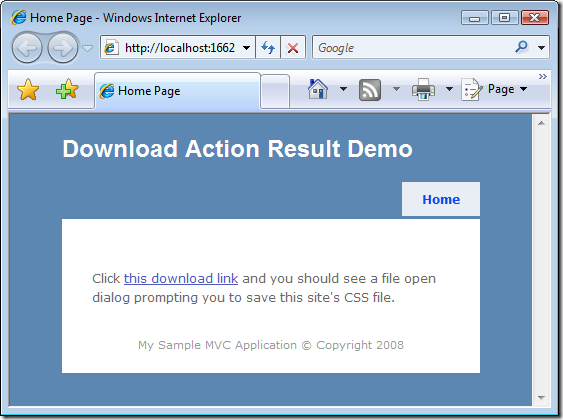Writing A Custom File Download Action Result For ASP.NET MVC
NEW UPDATE: There is no longer need for this custom ActionResult because ASP.NET MVC now includes one in the box.
UPDATE: I’ve updated the sample to include a new lambda based action result. This also fixes an issue with the original download in which I included the wrong assembly.
The April CodePlex source drop of ASP.NET
MVC
introduces the concept of returning an ActionResult instance from
action methods.
ScottGu wrote about
this change on his
blog.
In this post, I’ll walk through building a custom action result for downloading files. As you’ll see, they are extremely easy to build. Let’s start at the end and see what the end-user behavior of this new result will be.
Here’s a page that contains a link to an action method named
Download.This action method returns this new DownloadResult action
result.

Clicking on the link then pops up this dialog, prompting you to download and save the file.

The code for this action is pretty simple.
public ActionResult Download()
{
return new DownloadResult
{ VirtualPath="~/content/site.css", FileDownloadName = "TheSiteCss.css" };
}
Notice that you just need to give the result two pieces of information, the virtual path to the file to send to the browser and the default filename to save the file as on the browser.
The virtual path is set via VirtualPath property (surprise surprise!).
Note that I could have chosen to make this parameter accept the full
file path instead of a virtual path, but I didn’t want to force users of
this class to fake out a Server.MapPath call in a unit test. In any
case, the change is trivial for those who prefer that approach. I might
add overloads that accept a Stream, etc…
The file download name is set via the FileDownloadName property.
Notice that this is the filename that the user is prompted with.
If the FileDownloadName property is set, the ExecuteResult method
makes sure to add the correct content-disposition
header
which causes the browser to prompt the user to save the file.
For those familiar with Design Patterns, action results follow the pattern commonly known as the Command Pattern. An action method returns an instance that embodies an command that the framework needs to perform next. This provides a means for delaying the execution of framework/pipeline code until after your action method is complete, rather than from within your action method, which makes unit testing much nicer.
Speaking of unit tests, here’s the unit test for that download action method I wrote. As you can see, it is quite simple.
[TestMethod]
public void DownloadActionSendsCorrectFile() {
var controller = new HomeController();
var result = controller.Download() as DownloadResult;
Assert.AreEqual("TheSiteCss.css", result.FileDownloadName);
Assert.AreEqual("~/content/site.css", result.VirtualPath);
}
Here’s the code for the DownloadResult class. This is the class that
does all the work (not that there is much work to do). I do have unit
tests of this class in the included source code which demonstrate how to
unit test a custom action result.
public class DownloadResult : ActionResult {
public DownloadResult() {
}
public DownloadResult(string virtualPath) {
this.VirtualPath = virtualPath;
}
public string VirtualPath {
get;
set;
}
public string FileDownloadName {
get;
set;
}
public override void ExecuteResult(ControllerContext context) {
if (!String.IsNullOrEmpty(FileDownloadName)) {
context.HttpContext.Response.AddHeader("content-disposition",
"attachment; filename=" + this.FileDownloadName)
}
string filePath = context.HttpContext.Server.MapPath(this.VirtualPath);
context.HttpContext.Response.TransmitFile(filePath);
}
}
I removed the download since this code is no longer needed nor relevant.
Comments
40 responses